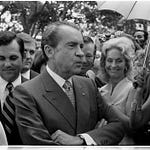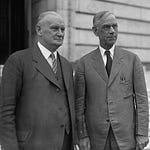
This week, we explore a pivotal economic question inspired by Milton Friedman. Do higher wages cause inflation, or are they a tool for economic stability?
It's important to remember that supporting low wages inherently means supporting social programs. So, should we raise wages for the lowest earners, or should we allow the bureaucracy to manage the funds? If we choose to raise wages, does this lead to increased inflation?
This question forms the basis of our discussion today and is the first of two key inquiries related to Friedman’s economic theories.
Milton Friedman
Milton Friedman (1912 to 2006) was a highly influential American economist, statistician, and leading proponent of the Chicago School of Economics. He taught economics at the University of Chicago for over 30 years and advised Presidents Nixon and Reagan on economic policy. In 1976, he won the Nobel Memorial Prize in Economic Sciences for his achievements in economics. In the 1970s, during a period of severe economic stagnation and high inflation known as stagflation, Friedman gained notoriety by disproving prevalent economic theories that did not consider stagflation possible.
We remember Friedman for his strong belief in free-market capitalism and skepticism of government intervention in the economy. He argued that the primary responsibility of a business is to be profitable and return value to stakeholders. In doing so, these stakeholders would have the resources to make decisions and achieve autonomy consistent with their values. He believed that the role of government in the economy should primarily be to increase the money supply at the same rate as the potential growth of gross domestic product (GDP) and to otherwise not interfere. Increasing the money supply at a rate faster than economic growth only increases inflation without driving economic growth.
During Ronald Reagan's presidency, Friedman’s advocacy for free-market principles significantly influenced supply-side economics. Supply-side economics became commonly known as Reaganomics. Core aspects of Reaganomics included significant business tax cuts intended to stimulate investment and economic growth by increasing the after-tax return on investment.
Reaganomics reduced government regulation. Friedman argued this effort would eliminate inefficiencies and encourage entrepreneurship. To address inflation, Reaganomics intended to control the money supply, a direct application of Friedman’s monetary theory. Finally, the push for reduced government spending reflected Friedman’s skepticism about the government's role in the economy. He advocated for a system where market forces could operate with minimal government interference. These policies intended to reduce government influence in the economic sector, enhance individual freedom, and promote economic growth.
Reaganomics, while aimed at economic revitalization, also increased poverty and inequality. Reagan himself expanded some social programs. We’ll remember that as related to the theme for next week.
This nuanced outcome leads us to Friedman's dichotomy: the economist who disavowed government solutions to economic problems also recognized the necessity of addressing poverty.
Friedman’s Dichotomy
Friedman famously disavowed government solutions to economic problems. In An Economist’s Protest (1975), he wrote:
I think the government solution to a problem is usually as bad as the problem and very often makes the problem worse.
But in an interesting twist, Friedman recognized that some lived in poverty, and we had a shared duty to alleviate that poverty. In Capitalism and Freedom (1962), he wrote:
We might all of us be willing to contribute to the relief of poverty, provided everyone else did. We might not be willing to contribute the same amount without such assurance.
Friedman’s dichotomy, which states that government solutions don’t improve problems while recognizing the need for government solutions to address poverty, raises two inherent questions.
Friedman spent much of his professional career addressing the causes of inflation. We often hear others say that we can’t raise wages because doing so would drive inflation. Do higher wages cause inflation?
If government intervention inherently makes problems worse but is needed to address poverty, then government intervention is necessary in either case. If government intervention is necessary regardless, why wouldn’t we use the government to make rules supporting the individual rather than funneling money through the bureaucracy?
First is the inflation question.
Wages and Inflation
Several factors cause inflation. These include demand-pull inflation, cost-push inflation, and monetary inflation.
In simple terms, think of these as inflation being caused by three separate forces. In the first, demand pulls prices up. For the second, costs push prices up. The third involves devaluing money, so you need more to buy something, which looks like prices are increasing.
First, demand-pull inflation. As summarized by Forbes, “Demand-pull inflation is when growing demand for goods or services meets insufficient supply, which drives prices higher.”
When demand exceeds supply, prices rise because some people are willing to spend more to outcompete others. This is a significant driver in today’s housing market. Because demand exceeds supply, and some are willing to spend more to outcompete others for a house, prices rise dramatically.
However, unlike the housing market, increased wages for low-income workers don’t increase demand-pull inflation because workers don’t have more money. There are two sources an American can get money. One is their work. The other is the government, which represents the American people’s money. If wages rise for low-income workers, they might get more money from their labor and less from social program support, but the total resources available are roughly the same.
Ultimately, the net effect of higher wages on demand-pull inflation is negligible.
Second, cost-push inflation. A University of California - Los Angeles (UCLA) study examined The Concept of Wage-Push Inflation: Development and Policy. Daniel Mitchell and Christopher Erickson led the effort. An excerpt:
Wage-push inflation…was associated with powerful, aggressive unions pushing wages up. In its simple form…costs go up which hapless employers are forced to pass through as price increases. The price increases trigger compensatory wage increases by unions and the cycle repeats…Few economists ever subscribed to such a simplistic view which suggested that the process occurred indefinitely without regard to economic circumstances. Nonetheless, popularizing the simple view was seen as advantageous to elements of the business community….
In cost-push or wage-push inflation, the costs of production increase (like raw materials or wages), and businesses pass these higher costs onto consumers in the form of increased prices.
But arguing against higher wages using a wage-push inflation argument negates the reality that if employers can’t, or refuse to, pay higher wages to control costs, they push the true cost of that labor onto the American taxpayer. If your business model requires you to pay poverty wages to maintain competitive prices, it’s not sustainable.
Ultimately, arguing that higher wages push prices higher is an argument in favor of passing the actual cost of wages onto the taxpayer. Wages indeed represent a business cost. The business, not the taxpayer, is responsible for paying for the cost of its labor.
The third type of inflation to consider is monetary inflation. When the total supply of money in the economy exceeds the country’s economic growth, this decreases the value of money and leads to higher prices. The stark rise in inflation following COVID was caused by government officials generating excess money that was not offset by productivity growth.
Dr. Friedman studied monetary inflation. He believed that the role of government in the economy should primarily be to increase the money supply at the same rate as the potential growth of gross domestic product (GDP) and not interfere otherwise. Increasing the money supply at a rate faster than economic growth only increases inflation without driving economic growth.
Higher wages don’t drive monetary inflation. Monetary inflation is a government phenomenon that is not associated with wages.
In sum, higher wages don’t drive demand-pull inflation.
Further, wages above poverty levels are irrelevant to the argument for cost-push inflation.
Finally, higher wages don’t drive monetary inflation.
So, higher wages don’t affect any of the inflation drivers. It seems that businesses paying higher wages doesn’t impact inflation after all.
Counterarguments
Higher wages can disproportionately impact small businesses, which operate on tighter budgets than large corporations. This is true, especially in the short term.
To mitigate the impact on America’s small businesses, we can offer tax incentives to small businesses that pay higher wages to help offset the increased labor costs. We can provide access to training to improve business efficiency and help small businesses manage higher wages without sacrificing profitability.
Retail and hospitality, which traditionally rely on low-wage labor, might be particularly vulnerable to wage increases. Higher labor costs could lead to higher service prices, potentially reducing consumer demand.
We should offer more tax incentives to small business service industries to keep low-margin small businesses competitive with large corporations.
Further, higher wages would lead to increased consumer spending, stimulating economic growth. This increase in demand could offset the impact of higher costs on businesses. Higher wages would also lead to lower employee turnover and higher productivity, offsetting some of the costs of higher wages for businesses.
Critics argue that higher wages might squeeze the margins of small businesses, leading to job cuts or business closures. Proponents argue for a different perspective. They suggest that a dynamic economy, spurred by increased consumer spending, small business tax relief, and dedicated support, can more than offset the initial challenges associated with rising wages. This approach addresses small businesses’ immediate financial concerns and promotes long-term economic growth and stability for individuals, reflecting Friedman’s advocacy for a robust and adaptable market economy.
Milton Friedman’s dichotomy, which states that government solutions don’t improve problems while recognizing the need for government solutions to address poverty, raises two inherent questions.
Friedman spent much of his professional career addressing the causes of inflation. We often hear others say that we can’t raise wages because doing so would drive inflation. Do higher wages cause inflation?
Higher wages don’t drive demand-pull inflation. If wages rise for low-income workers, they might get more money from their labor and less from social program support, but the net effect of higher wages is negligible.
Livable wages are irrelevant to the argument for cost-push inflation. Arguing that higher wages push prices higher favors passing the actual cost of wages onto the taxpayer. The business, not the taxpayer, is responsible for paying for the cost of its labor.
Finally, higher wages don’t drive monetary inflation. Monetary inflation is a government phenomenon that is not associated with wages.
It seems like businesses paying higher wages doesn’t impact inflation after all.
Next week, we can consider our second question: If government intervention inherently makes problems worse but is needed to address poverty, then government intervention is necessary in either case. If government intervention is necessary regardless, why wouldn’t we use the government to make rules supporting the individual rather than funneling money through the bureaucracy?
May God bless the United States of America.














Share this post